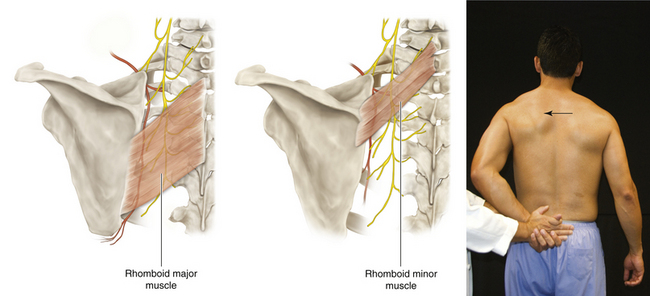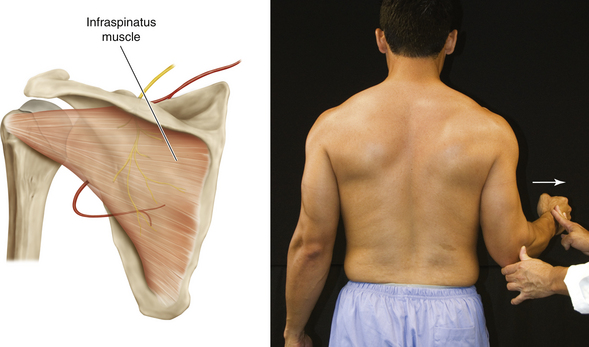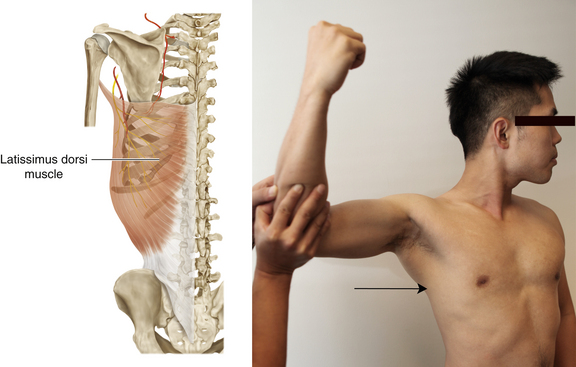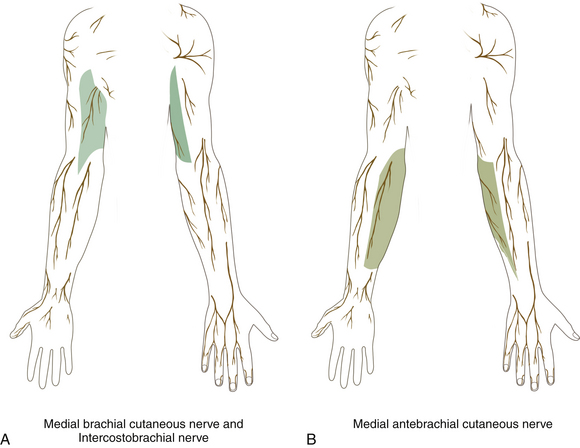Chapter 1 Anatomy and Function in the Upper Extremity
Note: Unless otherwise indicated, arrows in figures indicate the direction of patient motion.

Figure 1-2 Rhomboid Major and Minor Muscles
• Muscle attachments: Spinous processes of T2 to T5 (rhomboid major) and ligamentum nuchae and spinous processes of C7 and T1 (rhomboid minor) to medial border of scapula
• Innervation: Dorsal scapular nerve (C4 and C5)
• Function: Adduction; rotation of scapula
• Physical examination: The patient places a hand on his or her back and pushes backward against resistance. (Arrow: muscle bellies can be seen.)

Figure 1-3 Levator Scapulae Muscle
• Muscle attachments: Transverse processes of C1 through C4 to medial border of scapula
• Innervation: Dorsal scapular (C5) and cervical (C3 and C4) nerves
• Function: Raises scapula and inclines neck to corresponding side if scapula is fixed
• Physical examination: The patient tries to shrug the shoulders (arrows) against resistance.

Figure 1-5 Infraspinatus Muscle
• Muscle attachments: Infraspinatus fossa of scapula to middle facet on greater tubercle of humerus
• Innervation: Suprascapular nerve (C5 and C6)
• Function: External rotation of head of humerus at the shoulder joint
• Physical examination: The patient externally rotates (arrow) the upper arm at the shoulder against resistance.

Figure 1-6 Serratus Anterior Muscle
• Muscle attachments: Anterior surfaces of first eight or nine ribs to medial border of anterior surface of scapula
• Innervation: Long thoracic nerve (C5 to C7)
• Function: Abduction of scapula
• Physical examination: Patient pushes against resistance (e.g., the examiner’s hand or a wall). (If the serratus anterior is paralyzed, winging of the scapula can be observed.)

Figure 1-8 Subscapularis Muscle
• Muscle attachments: Subscapular fossa to lesser tubercle of humerus
• Innervation: Upper and lower subscapular nerves (C5 to C7)
• Function: Internal rotation of humerus
• Physical examination: The patient internally rotates the upper arm against resistance. (The main mover is the pectoralis major.)

Figure 1-9 Teres Major Muscle
• Muscle attachments: Dorsal surface of inferior angle of scapula to intertubercular groove of humerus
• Innervation: Lower subscapular nerve (C6 and C7)
• Function: Internal rotation and adduction of humerus at shoulder joint
• Physical examination: The patient tries to adduct (arrow) the elevated upper arm against resistance.

Figure 1-10 Latissimus Dorsi Muscle
• Muscle attachments: Spinous processes of T6 to T12, thoracolumbar fascia, iliac crest, and inferior three or four ribs to floor of intertubercular groove of humerus
• Innervation: Thoracodorsal nerve (C6 to C8)
• Function: Internal rotation and adduction of humerus at shoulder joint
• Physical examination: The upper arm is horizontal, and the patient is asked to adduct it against resistance. Also, in a relaxed, upright position, the patient is asked to cough; muscle bellies can be felt to contract when the patient coughs.

Figure 1-11 Pectoralis Major Muscle
• Muscle attachments: Anterior surface of medial half of clavicle (clavicular head) and anterior surface of sternum, superior six costal cartilages, and aponeurosis of external oblique muscle (sternocostal head) to lateral lip of intertubercular groove of humerus
• Innervation: Medial and lateral pectoral nerves—clavicular head supplied by C5, C6 (lateral pectoral nerve) and sternocostal head supplied by C6, C7, and C8 (medial and lateral pectoral nerves)
• Function: Internal rotation and adduction of humerus at shoulder joint

Figure 1-16 Coracobrachialis Muscle
• Muscle attachments: Coracoid process to medial surface of humerus
• Innervation: Musculocutaneous nerve (C5 to C7)
• Function: Internal rotation, flexion, and adduction of shoulder joint
• Physical examination: With the arm flexed and laterally rotated at the shoulder joint, the elbow completely flexed, and the forearm supinated, the patient flexes (arrow) the shoulder joint against resistance.

Figure 1-17 Biceps Brachii Muscle
• Muscle attachments: Coracoid process (short head) and supraglenoid tubercle of scapula (long head) to tuberosity of radius
• Innervation: Musculocutaneous nerve (C5 and C6)
• Function: Flexion at elbow joint and supination at forearm
• Physical examination: When the patient flexes (arrow) the supinated forearm against resistance, the muscle can be seen.
< div class='tao-gold-member'>






















